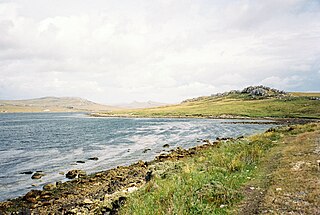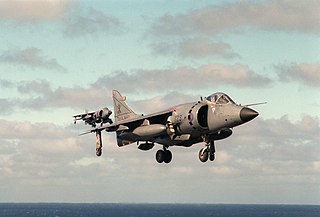
The Falklands War was a ten-week undeclared war between Argentina and the United Kingdom in 1982 over two British dependent territories in the South Atlantic: the Falkland Islands and its territorial dependency, South Georgia and the South Sandwich Islands. The conflict began on 2 April 1982, when Argentina invaded and occupied the Falkland Islands, followed by the invasion of South Georgia the next day. On 5 April, the British government dispatched a naval task force to engage the Argentine Navy and Air Force before making an amphibious assault on the islands. The conflict lasted 74 days and ended with an Argentine surrender on 14 June, returning the islands to British control. In total, 649 Argentine military personnel, 255 British military personnel, and three Falkland Islanders were killed during the hostilities.

The Battle of Goose Green was fought from 28 to 29 May 1982 by British and Argentine forces during the Falklands War. Located on East Falkland's central isthmus, the settlement of Goose Green was the site of a tactically vital airfield. Argentine forces were located in a well-defended position within striking distance of San Carlos Water, where the British task force had positioned themselves after their amphibious landing.

The Battle of Mount Harriet was an engagement of the Falklands War, which took place on the night of 11/12 June 1982 between British and Argentine forces. It was one of three battles in a Brigade-size operation all on the same night, the other two being the Battle of Mount Longdon and the Battle of Two Sisters.
The Battle of Two Sisters was an engagement of the Falklands War during the British advance towards the capital, Port Stanley. It took place from 11 to 12 June 1982 and was one of three battles in a Brigade-size operation all on the same night, the other two being the Battle of Mount Longdon and the Battle of Mount Harriet. It was fought mainly between an assaulting British force consisting of Royal Marines of 45 Commando and an Argentine Company drawn from 4th Infantry Regiment.

The Battle of Mount Tumbledown was an engagement during the Falklands War. The engagement was an attack by the British Army and the Royal Marines on the heights overlooking Stanley, the Falkland Islands capital. Mount Tumbledown, Mount William and Sapper Hill lie west of the capital. Due to their proximity to the capital, they were of strategic importance during the 1982 War. They were held by the Argentine 5th Naval Infantry Battalion, a reinforced, cold weather trained and equipped Marine battalion.

The invasion of the Falkland Islands, code-named Operation Rosario, was a military operation launched by Argentine forces on 2 April 1982, to capture the Falkland Islands, and served as a catalyst for the subsequent Falklands War. The Argentines mounted amphibious landings and the invasion ended with the surrender of Falkland Government House.

847 Naval Air Squadron is a squadron of the Royal Navy Fleet Air Arm. It operates AgustaWestland Wildcat AH.1 helicopters and provides armed reconnaissance and light transport support to UK Commando Force. Along with 845 and 846 naval air squadrons, it forms part of the Commando Helicopter Force. The squadron was re-formed from 3 Commando Brigade Air Squadron on 1 September 1995.
The Skirmish at Top Malo House took place on 31 May 1982 during the Falklands War between Argentine special forces from 602 Commando Company and the British Royal Marines of the Mountain and Arctic Warfare Cadre (M&AWC). Top Malo House was the only planned daylight action of the war, although it was intended to take place in darkness. The Argentine commandos were part of an attempt to establish a screen of observation posts. A section that occupied Top Malo House was sighted by a British observation post of the Mountain and Arctic Warfare Cadre that was screening the British breakout from the lodgement around San Carlos. The action at Top Malo House was one of a series of mishaps and misfortunes that afflicted the Argentine effort.

This is a list of the units, aircraft and casualties of the British air services in the Falklands War. The numbers in bold are the number of aircraft used in the war, the numbers in brackets are the number of lost aircraft. For a list of air forces from Argentina, see Argentine air forces in the Falklands War.
On 10 June 1982, in the closing days of the Falklands War, Many Branch Point, a ridge near Port Howard in West Falkland, was the site of a minor skirmish between the Argentine and British Armed Forces. The engagement ended with the death of the SAS patrol commander, Captain Gavin Hamilton. The action was the only ground engagement of the British and Argentine forces on West Falkland during the conflict.

656 Squadron AAC is a squadron of the British Army's Army Air Corps. It was chosen as one of the AAC new AgustaWestland Apache squadrons and in April 2004 started its conversion to role. The first phase of this completed in October 2004. The squadron was the first operational Apache squadron in the Army Air Corps and was awarded fully operational status along with the remainder of 9 Regiment AAC in June 2005. It is under 4 Regiment AAC as of 2007.

On 6 June 1982, during the Falklands War, the British Royal Navy Type 42 destroyer HMS Cardiff engaged and destroyed a British Army Westland Gazelle helicopter, serial number XX377, in a friendly fire incident, killing all four occupants. Cardiff, on the lookout for aircraft flying supplies to the Argentine forces occupying the Falkland Islands, had misidentified the helicopter as an enemy Lockheed C-130 Hercules. Although the helicopter's loss was initially blamed on enemy action, a subsequent inquiry found Cardiff's missile to be the cause.

The Bluff Cove air attacks occurred 8 June 1982, during the Falklands War. British troop transport ships were bombed by Argentine Air Force (FAA) Douglas A-4 Skyhawk fighter bombers at Port Pleasant, off Fitz Roy, while transferring troops to Bluff Cove, with significant damage and casualties.
The Battle of San Carlos was a battle between aircraft and ships that lasted from 21 to 25 May 1982 during the British landings on the shores of San Carlos Water in the 1982 Falklands War. Low-flying land-based Argentine jet aircraft made repeated attacks on ships of the British Task Force.
The Battle of Mount Kent was a series of engagements during the Falklands War, primarily between British and Argentine special forces.

Blue Beach Military Cemetery at San Carlos is a British war cemetery in the Falkland Islands holding the remains of 14 of the 255 British casualties killed during the Falklands War in 1982, and one other killed in early 1984. It is situated close to where 3 Commando Brigade had its initial headquarters after landing on 21 May 1982.

3 Commando Brigade Air Squadron, Royal Marines, was formed in 1968 in Singapore by the amalgamation of three Commando Air Troops and the Brigade Flight. The squadron moved to Plymouth in 1971 and the two remaining UK Commando Air Troops became part of it. Apart from during the Falklands War, when the whole squadron was involved, it operated mostly on individual flight detachments. 3 Commando Brigade Air Squadron became 847 Naval Air Squadron in 1995.
The 25th Mechanized Infantry Regiment is an infantry unit of the Argentine Army belonging to the 9th Mechanized Brigade, 3rd Army Division, and based at Sarmiento, Chubut, Argentina. This Regiment was the first army unit to land in the Falkland Islands on 2 April 1982 and fought in the Falklands War.

The 601 Commando Company is a one of three commando units of the Argentine Army (EA).
The South Yorkshire Aircraft Museum (SYAM) is a Volunteer led museum located at Lakeside in Doncaster, South Yorkshire, England. It occupies the former site of the Royal Air Force Station, RAF Doncaster. The museum occupies the last remaining original buildings from RAF Doncaster in the shape of a Bellman hangar, two wooden Air Ministry 'Billet Huts' (Buildings 19 and 21) and various smaller structures. The museum has also erected an more modern ex Air Training Corps Cadet Hut alongside Building 21 to house its World War Two Collection.












